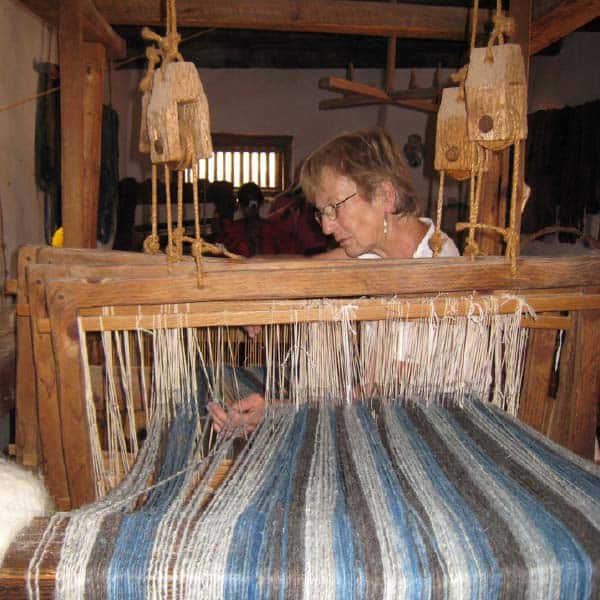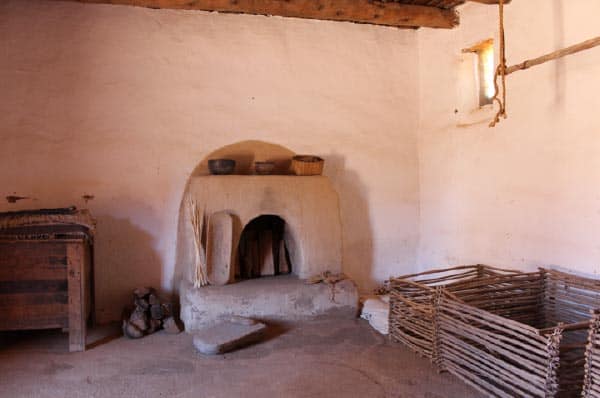El Rancho de las Golondrinas Placita Narrative—Part 3

Talleres de Hilar y Tejer
Weaving and Spinning Rooms
In 1540, the first sheep were brought to New Mexico with Francisco Vasquez Coronado’s expedition. They were driven along with the expedition and used tofeed the soldiers during their two-year exploration of the Southwest. With the Spanish colonization of New Mexico in 1598, sheep were utilized as more than just food. Herds of churro sheep were brought north from Mexico and raised on the plains of the northern frontier for their wool. Weavers knowledgeable in treadle looms and dyeing produced finished products that sustained the colony. By 1638, weaving appears to have developed beyond local consumption as New Mexico Governor Luis de Rosa was producing woolen goods in Santa Fe workshops for trade with the rest of New Spain for much needed goods.
Pueblo Indians already had a tradition of growing, spinning and weaving cotton. In the early 17th century, Pueblos learned how to use wool from the Spanish while still using their traditional upright looms. Wool quickly became integral to Pueblo weaving traditions that was later passed on to the Navajo. As flocks grew the sheep themselves, which flourished on the New Mexico plains, were driven south for barter and sale. Flocks continued to grow in the following centuries, as did the production of wool and woolen goods. Authorities in New Spain recognized the importance of the sheep trade and wool production to New Mexico’s economy. The market was greatly expanded with Mexican Independence in 1821 and the opening of the Santa Fe Trail that same year. By 1840, it was reported that 20,000 Rio Grande blankets were sold in Mexico.
Trade with California offered an even greater boost as wool, woven goods and sheep made their way from New Mexico to the West Coast. In 1853, Kit Carson drove 6,500 sheep from Taos to Sacramento. By the early 20th century, the sheep and wool industry had declined greatly because of cheap goods brought by the railroad, overgrazing and the loss of grazing lands. Despite this, woven goods figure prominently in New Mexico’s cultural and artistic heritage today.
These three rooms show how the Spanish colonists carded, spun and wove wool to make rugs for the floor, blankets for the bed and horses and clothing including serapes (blankets or shawls worn by men) and rebozos (shawls worn by women). Wool, woven goods and sheep were the most important commodity and export from New Mexico besides slaves. Wool could be left as its natural color or prepared with natural dyes. Dye stuffs were typically grown on the ranch but brilliant blues such as indigo and rich reds such as cochineal were imported from Mexico on the Camino Real.
- The looms are all contemporary or reproductions and only the large four-harness beam loom is an accurate reproduction of a Rio Grande loom. These looms were multiple harness “walking” beam looms, meaning that the weaver stood while weaving and operating the treadles, essentially “walking” on the treadles.
- Spinning was almost exclusively done by malacate (spindle). The weights or whorls for these spindles were often fashioned from broken pottery. A variety of spinning techniques were employed including the drop method which could be done while walking or standing, the thigh method which was done while sitting and also the method of using a bowl to support the spindle which was also done while seated. There was a certain practicality to using malacates in that they were easily transportable and could be used anywhere. It is interesting to note that carding and spinning was typically done by women and captives, while weaving was predominantly done by men.
- There were ruecas (spinning wheels) but these were much less common due to their expense, size and the material and tools required to make them. The rueca seen in the Spinning Room is a contemporary descendents of the Spanish colonial rueca and is still used in Mexico today. Characteristic traits of this type of rueca are a horizontal bench and small wheel turned by a handle attached to its center. This was quite different from the Scottish walking wheels that have a steeply angled bench and a large wheel as tall as the operator.
- Other tools of the weaver include weaving battens to separate the warp shed and facilitate adding yarn to the weft pattern. Shuttles which hold yard and are shaped to easily slide through the sheds of yarn when operating a treadle loom. Carding combs used to separate wool fibers in preparation for spinning. Skein winders used for preparing and measuring spun wool in preparation for weaving of sale.

El Cuarto de los Cautivos y los Criados
The Captives’ and Servants’ Room
The history of slavery, captivity, peonage and servitude in New Mexico is a long and difficult story. The earliest years of the colony’s history involved a system called encomienda, a demand for tribute goods and labor used throughout the colonial world. Given the especially harsh conditions of life on the far northern frontier of New Mexico, the encomienda along with disease and other abuses led to the Pueblo Revolt of 1680. The encomienda system was eventually abandoned after the return of Spanish colonists under Don Diego de Vargas, however some aspects of the tribute system continued. Against this backdrop, there was also the widespread practice of raiding and stealing of humans — especially women and children — being practiced by many tribal groups and the colonists.
The great value of this human capital can be parsed from trade reports citing slaves sold in Mexico proper and those sold were high priced commodities. One of the terms given for those who were separated from their tribes was gení zaro (detribalized Native Americans). By some estimates almost one-third of the population of the area consisted of people with some form of mixed ancestry and/or separation from their original people through captivity, slavery and peonage.
In our prosperous Rancho it is likely that captives were purchased through barter and then “rescued” in a fictive form of salvation called rescate where captives were baptized by the church and “saved” by their owners thus avoiding the laws that forbade slavery. The lives of these individuals were very much dependent on the luck of the draw — they could be used harshly or brought into the family in a modest way but still their labor and care was at the discretion of their owners. Even though the colony was far from centers of power, this was a highly stratified society where servants and slaves had few rights while vecinos (citizens) and the highest levels—the Dons and Doñas (honorific titles) — were given access to legal and economic benefits.
Unlike the chattel system of slavery in the American South, the children of this colony’s slaves could make their way in the world and extraordinary individuals were known to have bartered their abilities to become prosperous and well-regarded. In time, through avenues such as the rescate and other kinship alliances, tribal and mixed heritage individuals became part of the overall population and their past hidden — in similar fashion to crypto Jews. Few of the slaves or peons of this colony were of African heritage. In terms of marriage, “Captives had limited opportunities to achieve socially approved marriages…theoretically, a captive gained freedom by marrying. This naturally gave owners strong motivation for preventing marriage. In fact the small number of marriages that occurred shows how successful owners were at preventing marriage. What formal control owners had in this matter is not known, but whatever pressures they brought to bear were effective. Social attitudes were perhaps of importance and the stigma of marrying a captive may have been enough to discourage these marriages.” (Brugge, “Navajos in the Catholic Church Records of New Mexico 1694-1875”, p. 117, 125).
Servants and peons could be fellow Spanish colonists. Men serving in the militia, with no other option, often resorted to selling their children into peonage in order to afford to equip themselves for the required term of service. As late as 1868, the United States government formally freed well over 300 individuals from peonage and slavery in New Mexico. Human trafficking in New Mexico was intense, went on for centuries, and had a profound effect upon all levels of the population.
At the Rancho, the servants and slaves would have likely slept in the kitchen or in their working quarters. In the captives room you see that a woman of Navajo origins is using her knowledge of weaving to make textiles that could be bartered for other goods. Other women and children would share this room with her. Their sleeping/working quarters are not markedly different from those of the rest of the family but all that you see would have belonged to the owner family and not to the peon or slave. In general this room has few objects of comfort and value indicating the status of the individuals who reside here.
The large basket-like crates along the back wall are holding raw wool to be carded or spun. These types of crates were common in New Spain and would have come up the Camino Real to New Mexico loaded with goods on a caravan. Instead of disposing of them the colonists would have repurposed them as you see here. Other work that may be done in this room is the carding and spinning of wool. Grinding would have been done using the mano and metate with corn or wheat coming from the harinero. The Rancho would need as many metates going as possible and the prepared grain would be added to what was already ground in the kitchen.
- Open basket-like boxes or crates are used to store the raw materials of the weaver.
- Like other rooms, the servants or slaves have a rolled jerga mattress that is used for both sleeping and sitting.
- The textile on the upright loom is being made using the techniques and designs of early Navajo weavings. This type of vertical loom is a native design. Even smaller looms of similar design were portable and are known as back-strap looms.
- Navajo rugs and Hispanic weavings are displayed on hanging poles. These would be pulled down at night for bedding or used during the day for seating.
- A small fireplace provides warmth and light.
- A mano and metate in the room would be used by the captive or other servants, spending much of their time preparing corn meal or wheat flour.
- Storage of grain adjacent in the harinero was a convenience for the woman working at the metate.
- The only light source for the workers would have been daylight through the open door or the light of the fire at night. Precious tallow candles or oil lamps would have been reserved for the use of the Rancho owner’s family.
To download a printable version of this copy:
CLICK HERE
